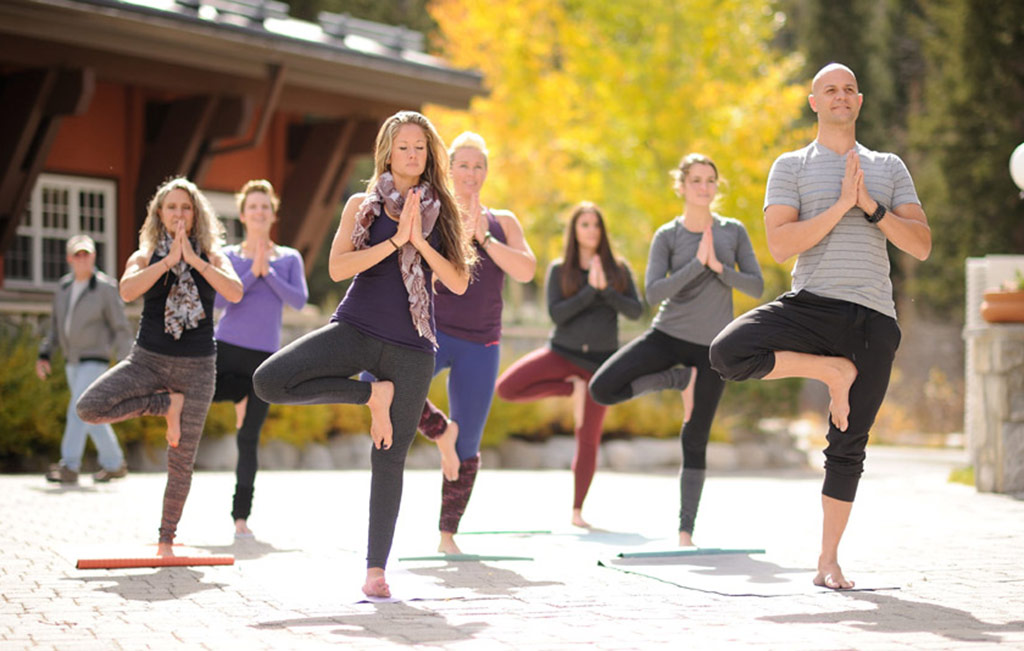
Trees are our partners in keeping this living, breathing planet alive. We inhale the oxygen that trees exhale, and they inhale the carbon dioxide we exhale. We are inextricably tied together.
Trees can also teach us about the importance of cultivating roots. While only the trunk, branches and leaves are usually visible to us, the roots of most trees are just as massive as what’s above ground. Knowing that this complex invisible root system is what keeps a tree upright can teach us about grounding our own bodies.
Vrksasana (Tree Pose) emulates the steady, rooted stance of a tree. When you practice, visualize your standing foot as the roots, your legs and torso as the trunk, your arms and upper leg as branches and your head and hands as the leaves. When you fully plant your standing foot, energy rebounds up your trunk, nourishing your branches and leaves.
Active Yield: Setting Down Roots
Grounding is most effective when you employ “active yield.” I first learned about active yield from Donna Farhi. It is applicable to literally everything we do. Here’s a brief explanation:
There are several ways of relating to gravity. Try this experiment:
- Collapsing: Stand on a nonskid mat in Tadasana (Mountain Pose) with your feet hips width apart. Now slump your shoulders and make your body very heavy, collapsing your weight into your feet. Note how you’re breathing. Return to Mountain Pose.
- Propping: From Mountain Pose, now pull your muscles into your bones and try to push the floor away with your feet. Lift up through your upper body. Pull in your rear and suck in your gut. Now try to breathe. Return to Mountain Pose.
- Active Yield: From Mountain Pose, now bend your knees a bit and yield your weight to the ground. Now press your feet into the floor, as if you’re sending roots down into the ground. It’s the same movement you make when you’re preparing to jump—pushing into the floor to lift the body up off the floor. Try it, only don’t let your body leave the ground. Do you feel an upward rebound through the rest of the body? This is active yield.
How to Practice Vrksasana
- Stand in Tadasana on a nonskid yoga mat. Close your eyes and feel how your feet are contacting the floor. Yield your weight into your feet and then root them into the floor.
- Shift your weight fully onto your right foot.
- Root your right foot as you bend your left knee and place your left foot into either the right inner thigh or the right calf. Avoid pressing your left heel into your right knee.
- Place your hands in Anjali Mudra (Prayer Position).
- Continue to root your right foot as you breathe and relax.
- If your balance feels steady, ground your right foot as you raise your arms up toward the sky.
- If your balance feels shaky, place your right heel into your left ankle with a few toes touching the floor. Remember that practicing balancing poses helps you develop the skill of balancing. If practicing with a couple toes on the floor challenges your balance, but allows you to feel the steadiness of rooting, the pose is helping you develop the skill of balancing.
- This article offers some options for practicing Vrksasana if your balance is shaky.
- Stay here, breathing deeply and planting your feet, for 5 to 10 breaths.
- Return to Mountain Pose. Take a few deep breaths, feeling your legs.
- Repeat on your other side.
In general, balancing poses not only teach our bodies how to maintain balance, but they also cultivate concentration. Balancing poses, such as Vrksasana, are a great way to center yourself at the start of your practice. You can also use them to collect your mind when you notice that your mind is scattered.
The more you practice balancing, the more you will notice how your body’s ability to balance changes from day to day. As you practice, make adjustments, standing close to a wall if need be, so that you work with your body instead of trying to force it to practice yesterday’s pose.
Vrksasana can help you start your morning with a collected mind, or calm you at the end of a stressful day. Practice with your roots firmly planted so that your trunk, branches and leaves can bloom.
Updated article from November 10, 2016.
